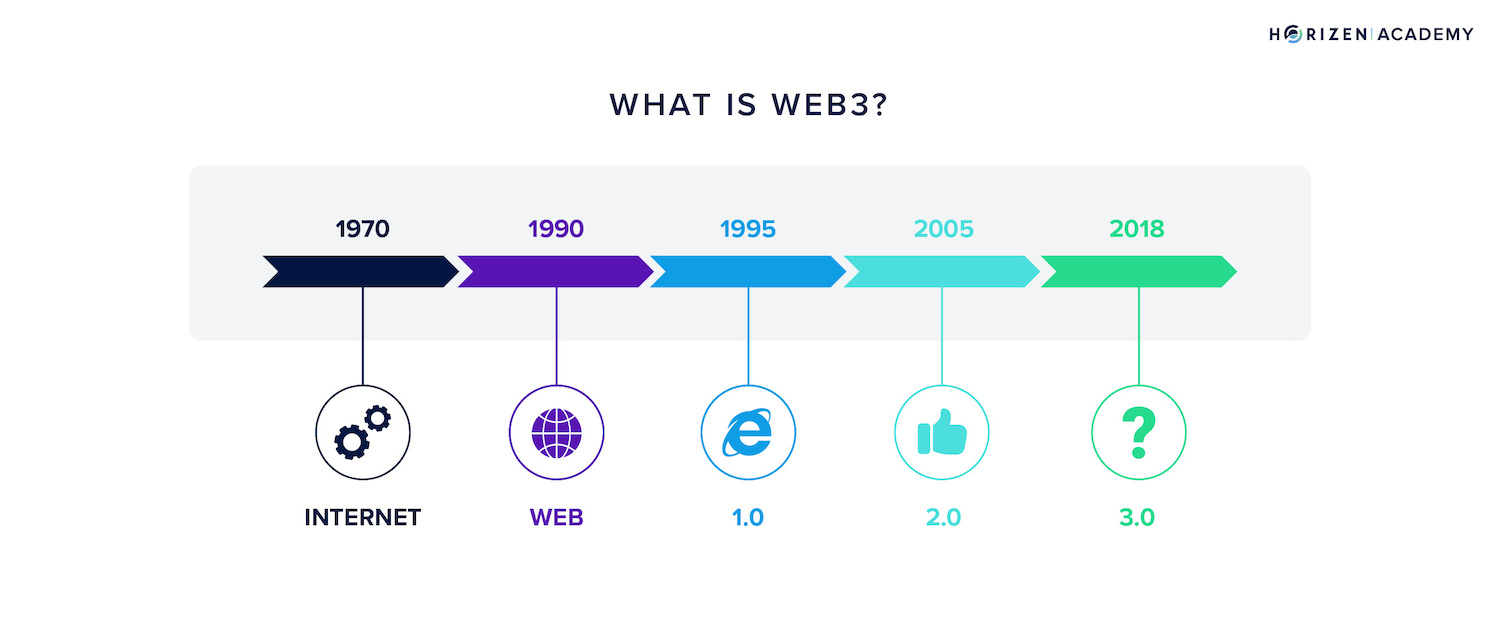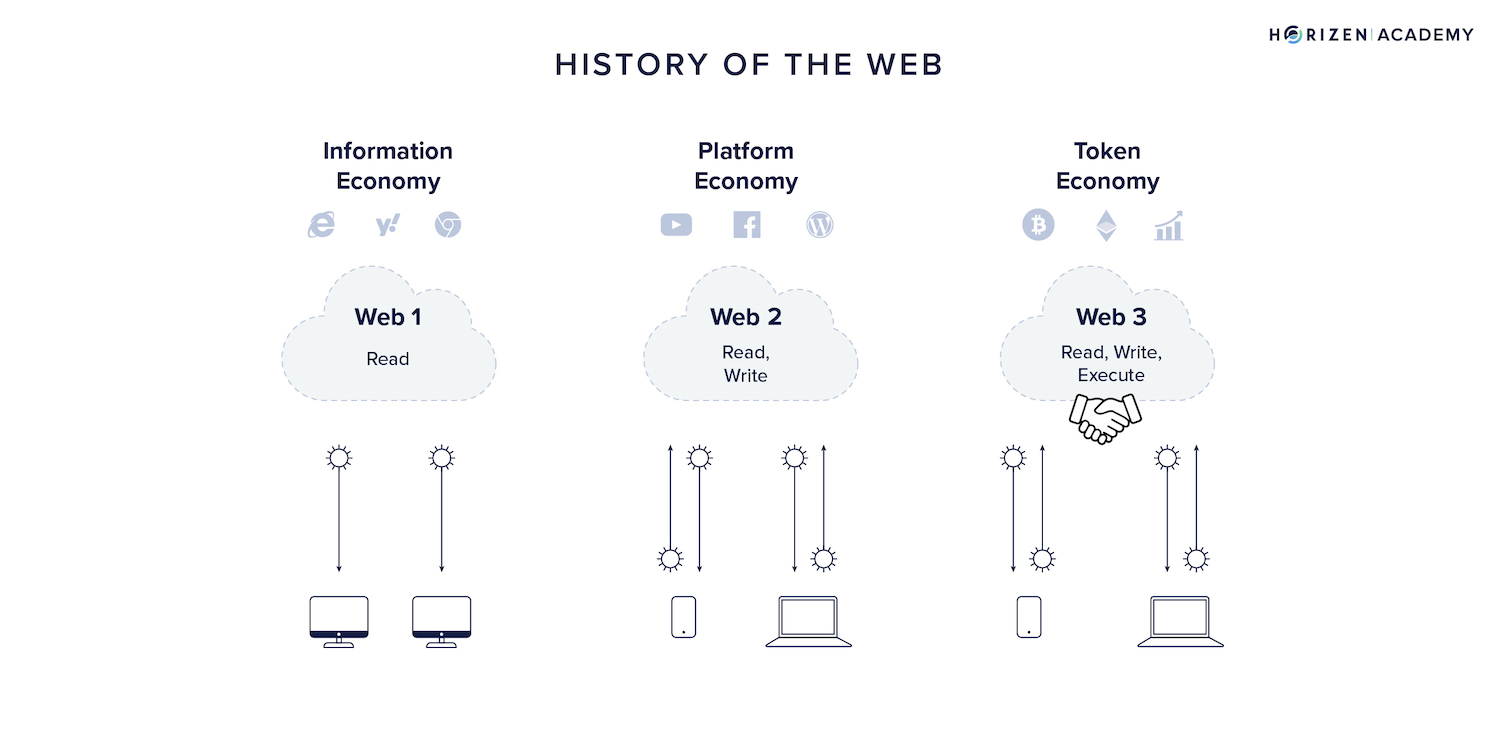What is Web3? - Web 3.0
Every few decades, a new technological advancement is made that reshapes the way in which information and value is created and shared between people.
Inventions like the printing press, the radio, the telephone and the internet have all served to broaden our ability to communicate and exchange information on a global scale.
Of all of these innovations, the internet has had the greatest impact by far in terms of broadening our capacity to communicate and make important decisions that impact billions of users.
Through the invention of the internet, society has increasingly become more interconnected as people share information that is propagated to billions of users around the world through an open and permissionless network.
The internet can best be chronicled into 3 stages of development: Web 1, Web2 and Web3.

Web 1: Read
Web 1 refers to the first iteration of the internet. This version can best be described as a ‘read only’ network that consisted of only static web pages linked together by a content delivery network.
The clunky user interface and limited access made it so that only a few people were publishers of content, while the vast majority of participants merely consumed information.
Platforms like Netscape, Britannica Online and personal websites built using HTML were all examples of Web 1.0.
Web 2: Read, Write
Web 2 expanded on the limitations of Web1 through the invention of social media platforms which made it much easier to create and publish your own content with everyone around the world.
The jump from a small group of publishers to empowering everyone to become a publisher enabled the internet to scale exponentially.
The Problems with Web 2
With Web2, the underlying platforms that enable users to publish information with the widest reach are controlled by a handful of powerful highly centralized tech companies such as Facebook, Twitter, and Youtube/Google.
These platforms can arbitrarily decide which publishers are allowed to share information on networks or how much visibility a piece of content should have.
Users are not only vulnerable to censorship on the application layer, but also on the infrastructure layer through cloud storage services like Amazon Web Services (or AWS), that enable millions of websites to stay running.
Through the digitization of money, Web2 has also propelled the existing power structures within our global banking and monetary systems to become even more centralized and capable of enforcing censorship.
The core premise of Web3 is to build a brand new internet from the bottom-up that harnesses the power of decentralization and open source technology to advance the way we exchange and authenticate information in the digital era.
Whereas Web2 was a ‘read, write’ iteration of the internet, Web3 aims to become ‘read, write, own’, meaning you are not only a participant in the network, but also an owner of what you produce and consume online.

Web3: Read, Write, Own
Web3 refers to a category of technologies that leverage internet protocols built on top of open source, distributed and decentralized systems.
Examples include: Blockchains, cryptocurrencies, smart contracts and different types of distributed ledgers.
Web3 enables network participants to not only publish and consume data, but also claim verifiable ownership of their data and prove scarcity of digital assets through the use of open, transparent and tamper proof ledgers called blockchains.
What is a Blockchain?
A Blockchain is a decentralized ledger (or record book) that is shared across a distributed network of computers (or nodes).
All nodes share the same copy of the ledger, and rely on majority consensus to determine when to update the ledger to reflect new changes in the form of newly confirmed transactions or network updates.
The most important use case for a blockchain is the ability to create and verify digitally scarce assets. Through consensus based systems, thousands of distributed nodes operating independently can coordinate to verify the exact quantity of a digital asset such as a cryptocurrency or NFT.
Bitcoin, the first use case of blockchain technology and the signature product of the Web3 era, is a decentralized, peer-to-peer digital currency that runs on a set of programmable rules (i.e protocols) which dictate its total supply and the rate of issuance of new bitcoin.
These rules are upheld by a global network of distributed nodes under a consensus mechanism called proof of work.
Sovereign Grade & Platform Grade Censorship Resistance
All Web3 networks aspire to achieve a sufficient level of sovereign grade or platform-grade censorship resistance
Sovereign-grade censorship resistance refers to the ability for a network to withstand a nation state attack. This is the highest form of a resistance that a network can achieve and it requires the network to be highly decentralized.
The Bitcoin network was designed to achieve sovereign-grade censorship resistance, meaning it could withstand an attack from a nation state that wished to destroy or control the network or manipulate its 21 million fixed supply.
Platform-grade censorship resistance refers to the ability for developers and creators to launch applications or publish information that cannot be censored by any platform.
This is a direct response to the wave of censorship that we have seen on big tech platforms such as Facebook and Twitter in recent years. Networks like Ethreum are designed to achieve platform-grade censorship resistance.
Ethereum is a decentralized network for developers to launch decentralized applications or DApps on the blockchain using smart contract technology.
Today, Bitcoin and Ethereum are the market leaders of the Web3 revolution.
In the past few years, we have seen an explosion of new decentralized protocols and applications that aim to solve unique problems in financial services, supply chain, healthcare, entertainment and other industries where disintermediating the middleman and establishing peer-to-peer networks can provide more efficient and equitable outcomes for participants in the system.
Will Web3 replace Web2?
For many people in the technology space, web3 is still a vaguely defined concept. Some believe it is the next phase of the internet that will completely replace the centralized and top-down platforms in favor of decentralized networks that unlock the full potential of human coordination and collaboration.
Others have a more nuanced take, believing that web3 will never fully replace web2, but instead compliment it by giving centralized companies the ability to leverage the benefits of decentralization which include transparency, security, immutability and censorship resistance, while maintaining their existing top-down structures, which are optimized for execution efficiency.
This model seems to be the favored path for the majority of traditional companies and increasingly some web3 native startups.
In the past year, community leaders of decentralized autonomous organizations (or DAOs) have become increasingly more vocal about the challenges that come with aligning incentives and managing feedback from hundreds of stakeholders, many of whom lack the necessary qualifications to add real value to the DAOs they contribute to.
These are some of the natural growing pains of operating in a purely decentralized environment.
The more stakeholders are empowered to voice their opinions, the slower organizations tend to move as they must overcome the consistent clashing of ideas between individuals and groups vying for influence.
In such an environment, DAO leaders are taking note of the benefits that come with creating well defined systems of hierarchy that enable DAOs to be efficient in how they execute without stifling debate which is essential to blockchain-based governance.
In other words, web3 systems seem to provide maximum benefit when it comes to empowering the collective to institute new processes and frameworks for decision making at the base layer (i.e how should decisions be made, what are the high level goals for the community or organization), while the actual execution of those decisions are best left to more centralized and top-down organizational structures that are optimized for efficiency.
This hybrid of decentralized and centralized decision making has already begun to be adopted at the technical layer as a way to scale blockchains.
With layer 2 networks, separate networks or channels are set up to enable transactions to be executed between a limited set of nodes, thereby reducing the time it takes to achieve consensus.
These transactions are periodically batched together and transmitted back to the layer 1 network (i.e the base layer), where they are validated by the L1 nodes using a more decentralized and robust consensus mechanism to ensure accuracy and maintain alignment with base layer consensus.
Given the effectiveness of this design on the blockchain tech stack, it only makes sense that the social/governance layer would adopt a similar framework for decision making.